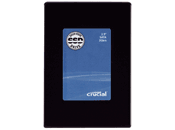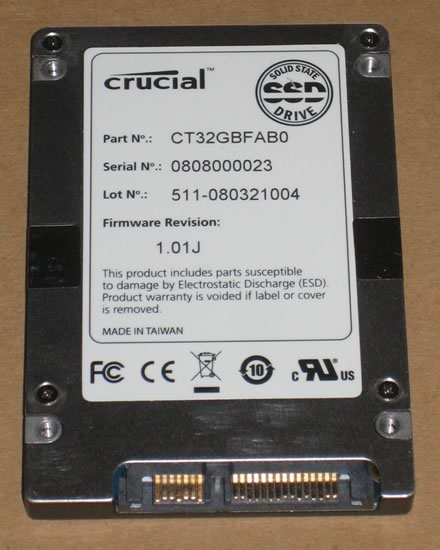1. About SSD drives, specifications
 Crucial is one of the biggest memory manufacturers around the world. The recent massive introduction of various solid state disks (SSD), especially for the notebook market, hasn't left Crucial out of the game. In fact today we will test the entry level model of Crucial's SSD line, which offers a capacity of 32GB.
Crucial is one of the biggest memory manufacturers around the world. The recent massive introduction of various solid state disks (SSD), especially for the notebook market, hasn't left Crucial out of the game. In fact today we will test the entry level model of Crucial's SSD line, which offers a capacity of 32GB.
Say goodbye to your hard drive: computing just took a new turn
 Introducing Crucial SSD (Solid State Drive) technology delivering the benefits of flash technology in a completely different way. More reliable, faster, and more durable than traditional magnetic hard drives, SSDs are a forward-thinking solution for mobile users who want longer battery life, and can't afford to lose or corrupt the data stored on their notebooks. Likewise, SSDs are a great alternative for the PC enthusiast who is always looking for the very best in system performance.
Introducing Crucial SSD (Solid State Drive) technology delivering the benefits of flash technology in a completely different way. More reliable, faster, and more durable than traditional magnetic hard drives, SSDs are a forward-thinking solution for mobile users who want longer battery life, and can't afford to lose or corrupt the data stored on their notebooks. Likewise, SSDs are a great alternative for the PC enthusiast who is always looking for the very best in system performance.
The advantages reach beyond the notebook, too. The innovative SK01 external storage kit integrates an SSD into your standard desktop PC and allows it to act as a portable USB storage device.
Why an SSD?
Put simply, SSDs are flash-based drives that offer greater reliability and faster performance than traditional magnetic hard drives. SSDs (solid state drives) are data storage devices that utilize non-volatile (do not lose data when power is removed) flash memory for computing applications that traditionally rely upon a mechanical hard disk drive. Crucial SSDs are designed as industry-standard drop-in replacements (via a SATA connection) for hard drives.
Consisting of just NAND, a controller, connectors, and a PCB, the SSD has no moving parts, creating greater stability by eliminating the mechanical delays and failures associated with a conventional magnetic hard disk drive.
What are the advantages of an SSD?
Superior reliability
The continuous motion generated by multiple moving parts creates heat, which is a leading factor in hard drive failure. In fact, hard drives are one of the notebook components most likely to fail. Because an SSD does not have moving parts, heat dissipation and noise are reduced or eliminated, resulting in a very rugged and reliable offering compared to a mechanical hard drive.
SSDs also have extreme shock and vibration tolerance, and their operating temperature ranges meet or exceed that of standard hard drives.
Increased power efficiency
Ever have your notebook battery die during a presentation? With no moving parts, SSDs require less power, improving battery operating time in notebook PCs and portable electronic devices.
Instant-load performance
Without the moving mechanical parts that cause latency issues, SSDs are not impeded by spin-up, seek time, or rotational latency. This equates to faster boot times, faster application loading, and greater overall system responsiveness. Via SATA, the Crucial 2.5-inch SSD offers a host data transfer rate of up to 3Gb/s, backward-compatible to SATA 1.5Gb/s.
Lightweight
Enjoy increased mobility with a lighter-weight SSD, which weighs less than a traditional mechanical drive.
Quiet acoustics
With no spinning parts, SSDs provide for silent operation, similar to that of a standard USB flash drive rather than the constant, noisy humming of a mechanical hard drive.
Reduced heat dissipation
Hard drives dissipate high levels of failure-inducing heat due to the parts necessary to operate the hard drive (such as the spinning platter). In contrast, SSDs produce little-to-no measurable heat because they have no moving parts, thus helping keep notebooks operating cooler.
- Full specifications
- Form factor: 2.5-inch industry-standard metal housing
- Dimensions: 100.2mm (l) x 69.85mm (w) x 9.5mm(h)
- Weight: 82g
- Available capacities: 32GB and 64GB (Actual usable memory capacity may vary. 1MB equals 1 million bytes; 1GB equals 1 billion bytes)
- Host interface: Serial ATA (SATA) 3Gb/s (backward-compatible with 1.5Gb/s)
- Host data transfer rate: 3Gb/s (backwards compatible with 1.5Gb/s)
- Read/write speeds: 32GB: up to 100MB/s (read), 60MB/s (write); 64GB: up to 100MB/s (read), 35MB/s (write)
- IOPS (inputs/outputs per second): 80K sequential read IOPS for a 512-byte transfer
- Shock: 1,500G/0.5msec
- Vibration: 20G (20-2000HZ)
- Temperature: Operating (0°C to 70°C); Non-operating (-40° to 85°C)
- Acoustics: 0dB
- MTBF (mean time between failures): > 1 million hours
- Endurance: Static & Dynamic wear-leveling with 6-bit ECC error correction
- Crucial Warranty: 5 years
2. The package, installation options
The Crucial 32GB SSD drive costs around $799 (+shipping), as found at Crucial's online store. The price is very high, compared to similar offerings from companies like Supertalent, although Crucial reputation, reliability and and hopefully performance may worth some extra spending.
The retail package is actually very small and includes just includes the SSD drive itself. For our tests, Crucial also provided us with the SK01 external package ($49.99) that offers you many connectivity options such as placing the drive into an external case or using it as an internal 5.25"/3.5" removable disk!





Crucial SSD drives come with a SATA2 (3GB/s) interface that is also compatible with SATA1 (1.5GB/s) ports. There is not any IDE/ATAPI version. A SATA-to-IDE converter might work for you, but anyway the SSDs target new laptop users and of course high end desktop users that definitely comes with a SATA interface.

The SK01 kit is sold separately. It includes a 2.5-inch external enclosure that can be connected to your PC through USB 2.0 or SATA interface. It also comes with an additional 3.5-inch SATA drive bay to allow for SSD integration into your PC. Don't have a spare 3.5-inch drive bay? Things are easy thanks to the included 5.25-inch drive bay bracket. This is very useful for hot-swap-supported systems, since you get enhanced security and mobility for your critical data by easily removing the SSD from desktop drive bays and storing it in a secure location, without even turning the computer power off.
The SK01 external drive kit is compatible with the usual 2.5" hard drives too.

In short, the SK01 external 2.5-inch storage kit is designed to house an internal 2.5-inch SSD for use in three different ways:
- Connection as an external USB 2.0 device for desktops or notebooks
- Connection via a SATA 3Gb/s port by way of installation into a 3.5-inch desktop drive bay
- Connection via a SATA 3Gb/s port by way of installation into a 5.25-inch desktop drive bay

The retail SK01 kit includes
 2.5-inch USB 2.0 external enclosure
2.5-inch USB 2.0 external enclosure- 3.5-inch hot swappable SATA drive bay
- 5.25-inch bracket
- USB cable
- SATA cable
- Power cable adapter
- Screw packets
- Protective carrying case
- User guide
Below you can see the main case, in which the SSD drive will be installed

Both SATA and USB ports are available:.


In case you need to install the SSD inside your PC, you can use the second adaptor and place it as a 3.5" floppy. In that case, a SATA cable should be used for connection to your motherboard's internal SATA ports, while the 3.5" power cable is the same you are probably using for your floppy drive.


3. Installation, benchmarks
The installation process is rather simple since no extra drivers are required. All you need is a motherboard with a SATA interface. The lack of moving parts means that you should not expect any noise as soon as the drive is up and running. For this reason, a small red led is available on the bottom of the SSD drive confirming that it is properly powered and connected.
After windows XP boot, we had the chance to get more information using Everest Ultimate Edition:

Everest Ultimate Edition offers various HDD benchmarks. Let's see a quick overview of the drive's reading performance:

The results are very impressive, the performance goes up from 84~130MB/sec depending the reading test. Going into subtests, we have a clearer view of the performance, during reading and writing tasks.
Read




Write




According to Everest Ultimate Edition, the transfer rates during reading reached the 120MB/sec while writing tasks gave a 75MB/sec.
The following graph comes from Sisoft Sandra, which lists SSD much higher than RAID 0 HDDs:

The HD TachRW software also gave very high reading/writing results

And finally, HD Tune gives us more information about the reading performance. Reading was done at 91.5MB/sec while the average seek time was just 0.4ms:

4. Conclusions
 Our first impressions from a the SSD technology are more than promising. Although the SSD market is not mature enough and such storage solutions would cost you a lot, their reading/writing performance will impress you. The Crucial 32GB SSD gave us an average reading performance of over 120MB/sec and around 70MB/sec during writing tasks.
Our first impressions from a the SSD technology are more than promising. Although the SSD market is not mature enough and such storage solutions would cost you a lot, their reading/writing performance will impress you. The Crucial 32GB SSD gave us an average reading performance of over 120MB/sec and around 70MB/sec during writing tasks.

The retail price is the Crucial drive is still high enough to keep you from buying it (~$799) and replacing your HDD. However, prices will drop shortly as soon as major memory makers decide invest more in the production, something that is expected to happen in the next couple of years. So what can we say about Crucial's SSD entry level proposal? It's blazing fast, performs according to its specifications, and the bundled SK01 add-on kit will become your next best friend in your mobile journeys. Too bad that Crucial doesn't offer an IDE/ATAPI version of the 32GB SSD drive, in order to replace the hard disk of our "old" Asus A6Ja laptop :-)